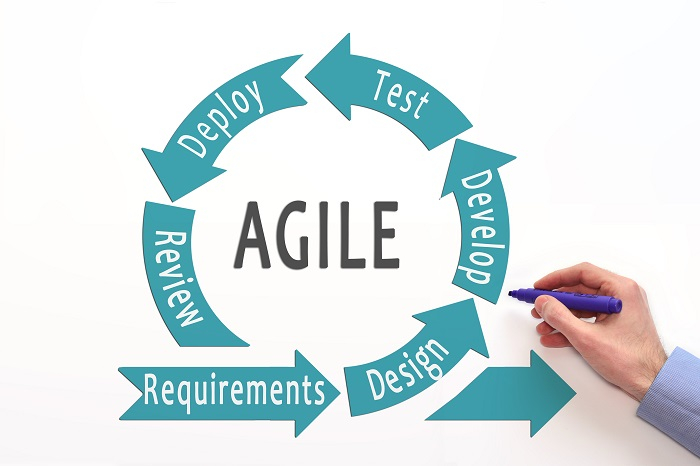
 Data Structure
Data Structure Networking
Networking RDBMS
RDBMS Operating System
Operating System Java
Java MS Excel
MS Excel iOS
iOS HTML
HTML CSS
CSS Android
Android Python
Python C Programming
C Programming C++
C++ C#
C# MongoDB
MongoDB MySQL
MySQL Javascript
Javascript PHP
PHP
- Selected Reading
- UPSC IAS Exams Notes
- Developer's Best Practices
- Questions and Answers
- Effective Resume Writing
- HR Interview Questions
- Computer Glossary
- Who is Who
Top 10 Agile Methodologies Every Business Should Incorporate
Agile project management has been quite popular among project managers over the past several years. The extensive use of Agile is not unexpected given that it closes numerous gaps left by conventional project management techniques and aids businesses in meeting challenging customer expectations. Additionally, Agile practically eliminates the possibility of a project failure.
When it comes to implementing Agile in business, numerous methodologies are accessible. In this tutorial, we will learn about the top 10 Agile methodologies that every business should incorporate.

What is Agile?
Agile project management is an iterative method of carrying out tasks. Due to the iterative nature of the method, a project advances via brief performance cycles that comprise planning, testing, improvement, and outcomes evaluation.
A team must gather stakeholder feedback while one of these agile cycles is still running. And after that little project cycle is over, the input obtained is used to schedule a new iteration for ahead in the future.
Top 10 Agile Methodologies
1. Waterfall or Gantt Planning
A waterfall model divides project work into multiple phases and begins with a plan. This progress in a predetermined order must be carefully followed and built upon one another. The work on the following stage doesn't start until the previous one is finished. As a result, the process is precisely defined and planned out before the project starts. Typically, this kind of planning is represented graphically using a bar chart, also known as a Gantt chart.
Waterfall or Gantt planning is very beneficial in organizations with hierarchical systems. In theory, it is ideal for large, foreseeable projects with constant requirements, i.e., without needing adaptation.
2. Kanban
This technique adheres to all the Agile model's principles. It is an incremental process in which openness in software development is the most important factor. A software developer employs Kanban boards with a three-step process?to do, in progress, and done-for project traceability. A card represents each work's condition. They are used for logging every work completed on a project and are shown on the board to provide a clear picture of the team's progress and the overall process.
3. Scrum
Similar to Kanban, Scrum separates the development processes into "sprints," or discrete time frames. By maximizing and dedicating time for each sprint's development, just one sprint is managed at a time.
The constant deliverables that Scrum and agile techniques emphasize allow designers to modify priorities so that unfinished or delayed sprints receive more attention. Scrum has clear structures yet is still adaptive. It integrates nicely with Kanban to create another agile approach known as the Scrumban.
4. Crystal
Unlike all the earlier frameworks, it doesn't have a set of guidelines or a particular method. The Crystal approach is based on various factors, which are color-coded. It includes crystal yellow, crystal diamond, crystal orange web, crystal clear, crystal maroon, crystal red, crystal sapphire, and crystal orange. A different color represents a distinct approach in the Crystal method family.
Crystal targets timely product delivery, regularity, reduced administration with high user interaction, and customer satisfaction, just as other Agile approaches. The project environment and the team size are major factors influencing each Crystal methodology.
5. Lean
Lean project management is more of a set of strategic concepts than a specific technique. The main objectives are process simplification, customer satisfaction, maximization of value creation, and waste elimination.
The fundamental idea behind the Lean software development approach is waste minimization. It is not a rigid system. Thus, it is possible to combine tools from different approaches in real-world situations. Therefore, it is a bridge connecting agile techniques and conventional thinking.
6. Extreme Programming (XP)
Extreme Programming (XP) prioritizes client satisfaction through continuous development. This approach places a strong emphasis on cooperation, transparency, and feedback. Similar to SCRUM, this paradigm also uses brief development cycles or sprints. It makes the atmosphere for software development teams very effective and productive.
XP is highly helpful in the face of ongoing and changing client expectations. It encourages the programmers to accept modifications to the customer's requirements, even if they appear during an advanced stage of the programming process.
7. Dynamic System Development Method (DSDM)
The Dynamic Systems Development Method (DSDM) was created to meet the demand for a uniform industry charter in fast software delivery. According to this approach, project adjustments should always be planned. It also highlights the importance of timely delivery and high quality. All of those are founded on a business-driven strategy.
It provides a thorough framework that is established and altered when a plan is created, carried out, managed, and scaled for software development.
8. Feature Driven Development (FDD)
The Feature Driven Development methodology contrasts Scrum or XP approach. This is because it emphasizes rigid processes involving domain walkthroughs. Additionally, it emphasizes design, coding, and inspection. The goal of FDD, which is focused on the developer, is to translate models into builds through iterations carried out every two weeks.
The main objective of FDD is to reliably and quickly develop functional software. The project lifecycle steps include creating feature lists, planning by feature, designing by feature, and constructing by the feature.
9. Scaled Agile Framework (SAFe)
The Scaled Agile Framework (SAFe) is a set of organizational and workflow principles for applying agile methods at an enterprise scale. Using SAFe, you may benefit from a comparatively lightweight framework while preserving the centralized decision-making necessary at the corporate level for software development efficiency. In other words, SAFe extends the agile principle to software executives dealing with larger strategic concerns.
10. Design Thinking
Design thinking is a method for optimizing creative ideas and solutions. These must be focused on the requirements of the user or client. Additionally, the outcome must be both technically and financially realistic.
The approach suggests forming multidisciplinary, heterogeneous teams in conducive environments. Iterative loops, including comprehension, observation, empathy, deation, prototyping, and refinement, make up the design thinking process. Early prototyping and frequent recapitulation are given special attention.
Conclusion
The fast-paced environment of business today has contributed to the popularity of agile project management. It provides greater project performance visibility and enhances project control. Although there are many ways to incorporate agile, choosing the one that works best for your company demands a flexible strategy. When choosing the ideal strategy for your company, always evaluate the benefits and drawbacks of each. Choose a framework that will enable you to deliver amazing digital experiences in this more cut-throat industry. Remember that the appropriate agile strategy also draws talent to your team.

